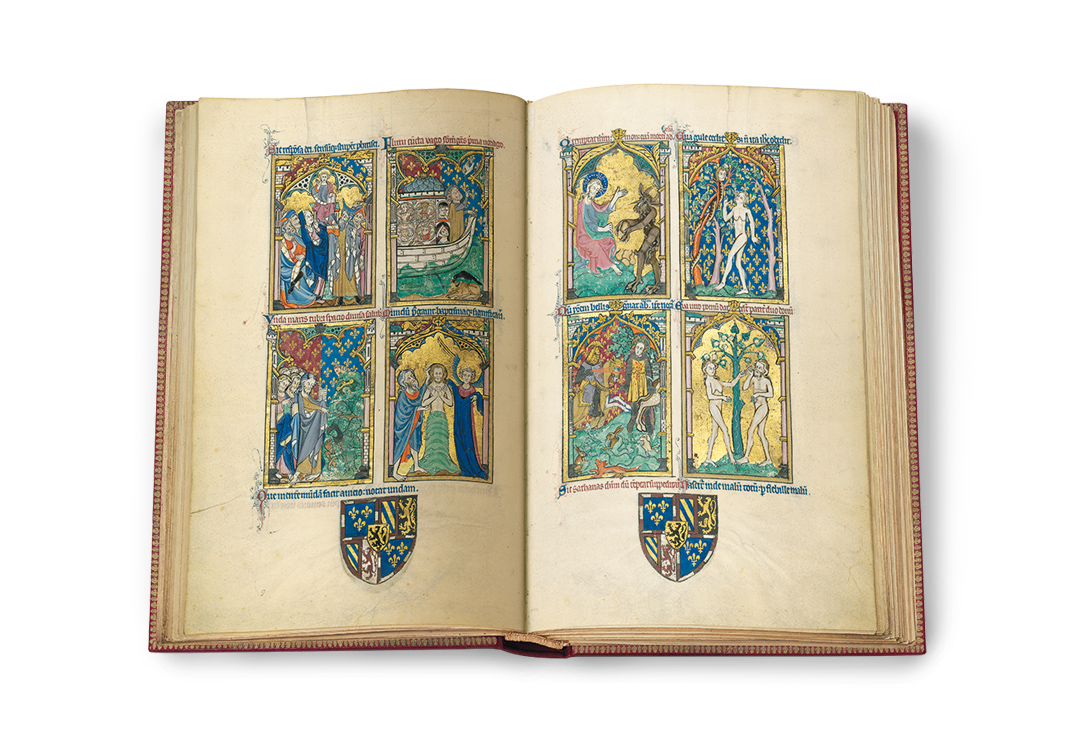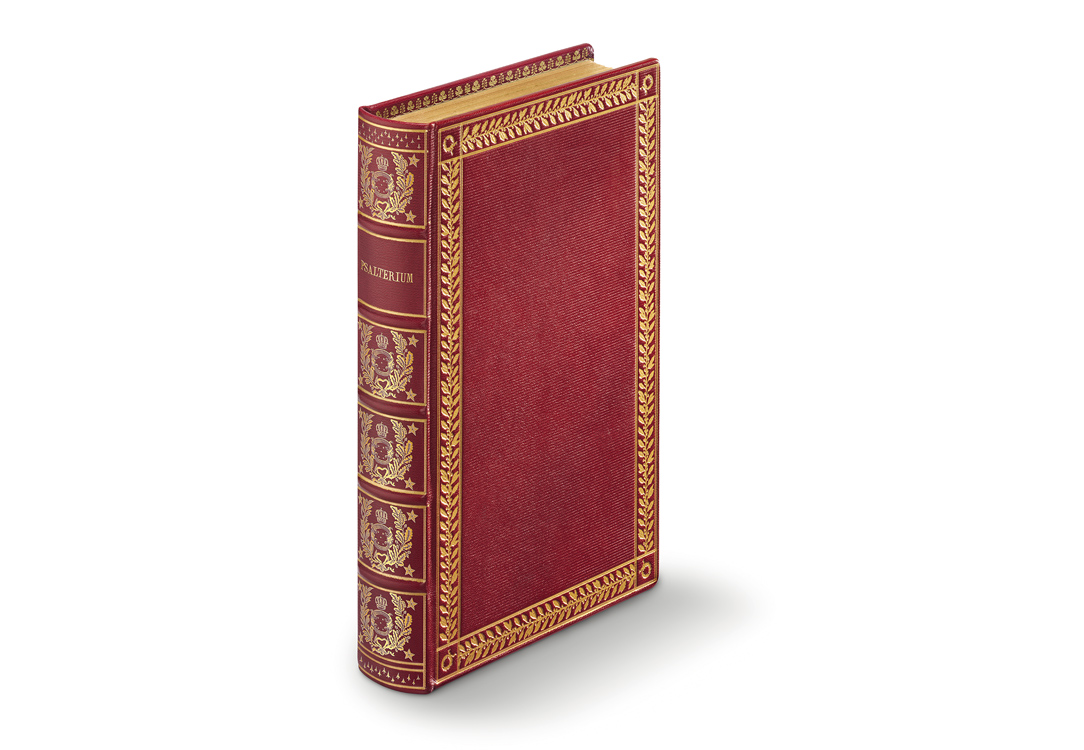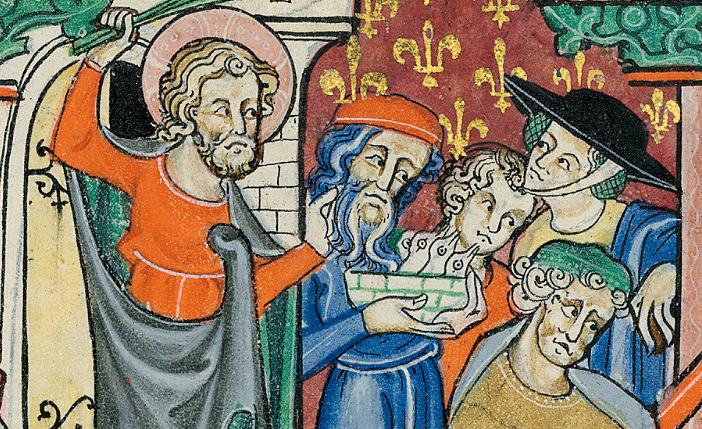The Peterborough Psalter
Magnificent Miniatures and Gilt Gothic Script
Indulge in lavish quantities of gold and brilliant colours! Open the Peterborough Psalter and enjoy the magnificent illustrations on every page: finely tooled gold backgrounds, fleur-de-lis and yellow gold decorated initials, line-fillers and figural motifs in the borders, precious colours and shining silver, gracefully swaying and expressive figures, scenes from the Old and the New Testament in Gothic miniatures.
The splendid Burgundian arms and the decorative fleur-de-lis emblem of the French kings are evident on every miniature page. The script of the text pages is entirely written in gold and blue lettering. Take great delight in looking at this masterpiece of book illumination and discover the marvelous variety of fine details!
Peterborough-Psalter
The Peterborough Psalter: The Manuscript
Innovative Artists of Book Illumination
The Peterborough Psalter was created by two main artists. The first master from London or Norwich set the tone by deciding upon a consistent design concept. The second master was primarily responsible for executing the decorative and pictorial program. The Peterborough Psalter is the only psalter to arrange the scenes of the New and the Old Testament in a typological correlation as opposed to depicting them in separate pictorial cycles. Each scene of the New Testament is associated with two, three or even four scenes of the Old Testament. Especially noteworthy are the quite secular representations in the border design and in the line and column fillers.
Patrons and Owners
The splendid psalter was written and illuminated around 1300 for the Benedictine Abbey of Peterborough, in the English diocese of Lincoln. The manuscript might have been commissioned by an aristocratic couple as patrons, though any potential coat of arms of the time is painted over today. The original owner of the manuscript is known to have been Geoffrey of Crowland, Abbot of Peterborough from 1299 to 1321. He is probably the figure depicted in a historiated initial on fol. 65r, where, accompanied by a Benedictine monk, he is represented at prayer before an altar on which stands a crucifix. The monastic owner notwithstanding, the book illumination contains a number of secular scenes from a romance of chivalry.
A Succession of Powerful Owners
The provenance of the Peterborough Psalter can be entirely traced throughout the centuries. In 1318 Abbot Geoffrey of Crowland offered the lavishly illuminated manuscript to the papal nuncio, who presented it to Pope John XXII. The pope then offered it to the widow of the French king, Clementia of Hungary, on the occasion of a visit by her. On her death, the psalter was passed on to Philip VI, the French king, and somewhat later it became part of the collection of his grandson, Charles V, who had the backgrounds of the miniatures decorated with fleurs-de-lis in gold. When the book entered the library of Duke Philip the Good of Burgundy, his arms were added to all the miniature pages. Some 350 years later, even Napoleon asserted his claim to the manuscript by having it rebound.
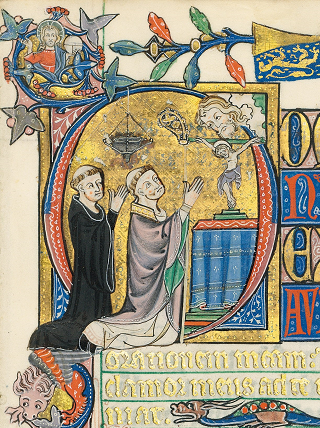
Peterborough-Psalter
Under the Magnifying Glass: The Gothic Art in Unrivalled Images
Figures depicted in elegant, slender proportions recount the stories of the Old and New Testaments. Their faces are carefully modelled in fine detail, and their individual facial expressions radiate vitality and physical presence. The background areas in gold are finely tooled, effectively alternating with the original monochrome backgrounds, which during the third quarter of the 14th century were decorated with the French royal fleurs-de-lis. The brilliant colours were made from the most precious pigments, giving the miniature pages the appearance of stained-glass windows. Making full use of their creativity and displaying a rich variety of motifs, the book illuminators were intent on occupying all of the pictorial space, thus filling the columns and lines with ornament.
On fol. 64r, the scribe wrote the last five lines of the text of Psalm 100 in gold ink at the top of the left-hand column above the miniature. Figurative line fillers complete lines 2 and 5. The miniature below shows the Deposition of Christ. Joseph of Arimathea receives Christ’s tortured body, while Mary and John are mourning. Balanced on a ladder, a man uses a wrench to detach Christ’s left arm from the cross. David was considered a prefiguration of Christ in medieval times, and so the miniature on the top right shows David rescuing a sheep. At the bottom left, Samson is carrying away the gates of Gaza. Both scenes refer to Christ’s descent into Hell. The scene at the bottom right refers to a type of the Resurrection: David is saved by Michal.
Peterborough-Psalter
The Peterborough Psalter: The Edition
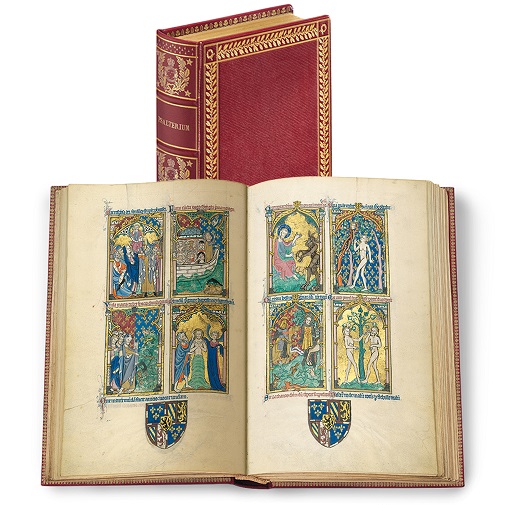
The Manuscript and the Facsimile at a Glance
The Peterborough Psalter presents the viewer with the perfect art of Gothic book illumination. Gold is sparkling on all the pages, gold letters are raised so that their contours can be touched, colours glow intensively in magnificent pictures. The facsimile edition affords an entirely novel quality of perception. The authentic impression of the subtle interplay of gold, colour and parchment fascinates the viewer.
Manuscript: Brussels, Bibliothèque royale de Belgique, Ms. 9961-62
Date of Origin: around 1300
Place of Origin: London or Norwich
Dimensions: c. 30.0 x 19.5 cm
Extent: 282 pages (141 leaves)
Artists: various book illuminators from a professional workshop
Parton: an unknown aristocratic couple
First Owner: Geoffrey of Crowland, Abbot of Peterborough
Illumination: 116 miniatures, 24 calendar medallions, historiated initials, borders, heraldry, line fillers, script in gold and blue throughout, five varieties of gold, tooled surfaces
Binding: red leather with gold tooling in Empire style
Commentary Volume for the Facsimile Edition by Lucy Freeman Sandler / Bernard Bousmanne
Print run: 680 copies
Peterborough-Psalter
Enjoy Viewing a Few Sample Pages:
A Glance at the Facsimile
The section of the Peterborough Psalter reproduced here comprises fols. 63v–67r. The sequence of pages starts with a text page in blue letters. Fols. 64r–64v show the miniatures depicting the Deposition, the Descent into Hell and Christ’s Resurrection, correlated with their antecedents from the Old Testament. The historiated initial at the beginning of Psalm 101 on fol. 65r supposedly shows the abbot of Peterborough kneeling in prayer. At the top of the decorated border, a man is playing two trumpets, and at the bottom an angel is playing one. In the historiated initial on fol. 66r, Benedictine monks are singing at a lectern. In the border at the bottom, a cleric is playing a portative organ, and another man is playing a bagpipe.
Peterborough-Psalter
A Challenging Production: fac simile
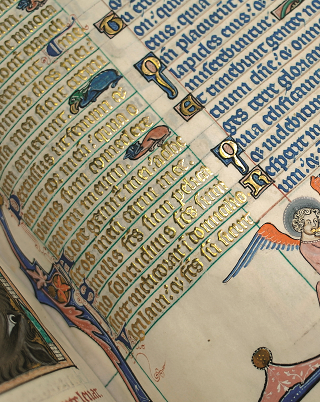
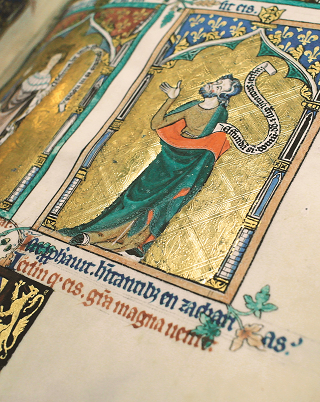
Gold on Every Page
The gold applied to the miniatures and to the script in the Peterborough Psalter appears in different shades of brightness. The gold background areas are punched, smoothly burnished or incised with elegantly swaying arabesque patterns. The contours of the applied gold ink are raised to the touch. Producing a facsimile of a manuscript illuminated with gold requires the highest standard of craftsmanship. After a number of trial runs the experts succeeded in reproducing the raised illumination of the sparkling original gold script. Further steps were necessary to adequately reproduce the tooled gold background areas. None of the patterns are exactly the same.
The Masterly Craft of Book Binding
In the wake of the occupation of the Austrian Netherlands by the French revolutionary army in 1794, the Peterborough Psalter was taken to Paris. Napoleon had it rebound in red leather in Empire style. The gold tooled border is characteristic of the classicist decoration.
For this facsimile edition, the leather carefully selected for the binding is dyed red, as is the original. A rich gold tooling is applied to the covers, the spine and the edges. True to the original, the volume is furnished with a pastedown and a flyleaf of green moiré silk.
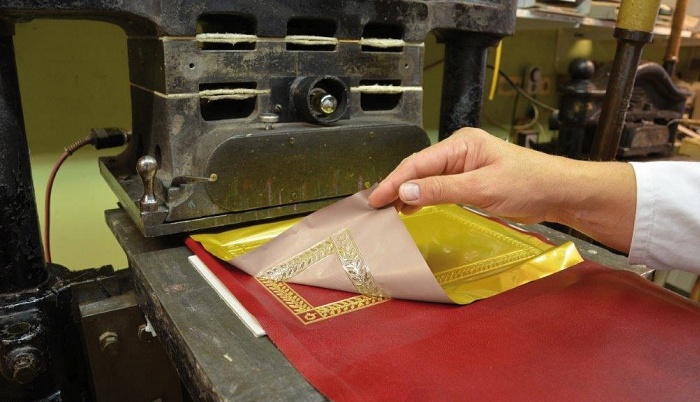
Peterborough-Psalter
The Facsimile Folder for the Edition
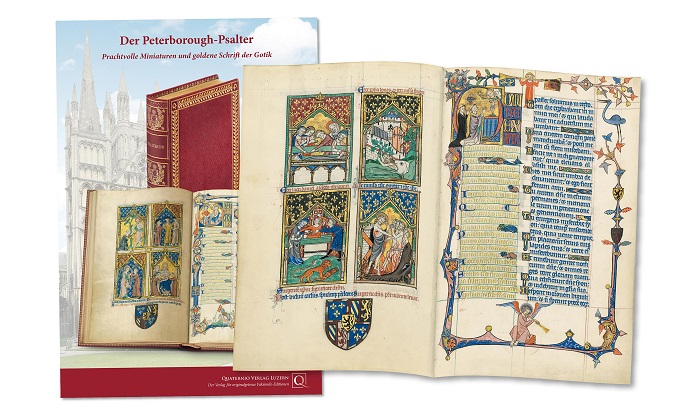
Quaternio Editions Lucerne has made a high-quality facsimile folder for you to become acquainted with the Peterborough Psalter. The folder contains one original gilt facsimile double-leaf with eight miniatures, raised gold script, splendid heraldry and a gold initial. When you turn the facsimile double-leaf you will get the impression of seeing, touching and listening to the sound of parchment, although it is in fact made of paper. Detailed captions explain the illustrations. By means of a 16-page brochure, learn more about the various pictorial subjects of the Peterborough Psalter, the remarkable provenance of the manuscript, and the challenges of the facsimile production.
Peterborough-Psalter
Order facsimile folder
Click here to go to the online shop (German only) where you can order the facsimile folder for the Peterborough Psalter edition. Or send us an email to info@quaternio.ch.
Request brochure
We would be glad to provide you with additional information regarding the fine art facsimile edition of the Peterborough Psalter. Click here to order the brochure.




